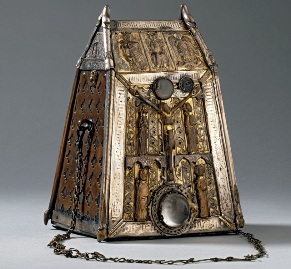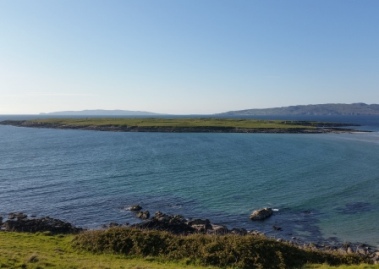
Two ancient artefacts synonymous with the early Christian period in County Donegal arrive back in the county this week on loan from the British Museum.
Their visit will be marked by an official unveiling by Joe McHugh TD, Minister of State at the Department of Arts, Heritage and Gaeltacht Affairs and the Department of Communications, Energy and Natural Resources on Friday, June 19 at 12.30pm in the Donegal County Museum, High Road, Letterkenny, Co Donegal.
St Conall Cael’s Bell and Shrine will be on display at the Donegal County Museum, High Road, Letterkenny from 3pm Friday June 19 to Saturday July 11. Admission is free.
On Monday 13 July, Donegal County Museum will facilitate their display at the Dolmen Centre, Kilclooney in South-West Donegal, after which they will return to the British Museum. This location was chosen by the local Homecoming of St Conall’s Bell and Shrine Committee because of its proximity to the original site of St Conall’s monastery on Inishkeel Island at Portnoo.
This visit of these iconic items represents a major coup for Donegal County Museum. This iron hand bell is said to have originally belonged to St Conall Cael in the 6th century. The bell is an early type made from a sheet of iron, its handle and loop for the clapper is missing. A plate of brass decorated with native Irish and Viking interlace ornament was added around the year 1000. Long after his death, in the 15th century ornate silver 'bell shrine' was made to protect and embellish the bell. It was worshipped by pilgrims during their turas on the island of Inishkeel.

A view of Inniskeel Island, Portnoo were St. Conall's Monastic Site was originally based the original site of St Conall’s monastery
When first recorded in modern times the bell and its shrine were in the possession of the O’Breslins. The bell was carried by its keeper and kissed by pilgrims during the turas on Inishkeel. After the suppression of the turas by local clergy in the early 19th century, the bell came into the possession of Major Nesbitt of Woodhill House, Ardara. After his death in 1845, the bell and shrine passed through a number of hands until they were purchased by Sir Augustus Franks who appreciated their historical significance and presented them to the British Museum in London in 1889.
Donegal County Museum has worked in partnership with the British Museum to facilitate the loan of these items and have had to comply with stringent conditions regarding security, the environmental storage requirements and security, including the transportation of the artefacts by specialist fine art couriers.
“We have worked closely with the British Museum to facilitate the visit of these iconic artefacts to Donegal. From the germ of an idea first discussed with the late Malachy Mahon to this momentous occasion, we have been committed to ensuring that St Conall’s Bell and Shrine can be displayed in the museum and can also visit the Dolmen Centre, Kilclooney, close to the original site of St Conall’s monastery on Iniskeel Island,” stated Donegal County Museum Curator, Judith McCarthy
The good news has also been welcomed by Donegal County Council Chief Executive, Seamus Neely.
“St. Conall Cael’s Bell & Shrine is an important part of the heritage of County Donegal. This is an excellent and unique opportunity for people to view these important artefacts and to learn more about their links to the story of Donegal. We are delighted to be involved with and to be approved by the British Museum for such a venture. It is a priceless artefact from our ancient history and it is fantastic that it is returning to the area from where it originated almost 1,500 years ago,” he said
St Conall Cael’s Bell and Shrine
St Conall Cael
According to the Genealogiae Regum et Sanctorum Hiberniae, St Conall was descended from the Cenél Conaill, one of the ruling families of Donegal. He was the son of a Maine or Caelmaine, who was a son of Cathair, son of Bogaine, son of Conall Gulban.
He founded a monastery on Inishkeel sometime in the 6th century. This ecclesiastical foundation was important to the spread of early Christianity in Donegal. St Conall died between 590 and 596 AD and is buried on the island. His feast day is May 22.
St. Conall is also connected with two sites near Bruckless, a holy well and an area known as the Relig. There is a foundation at Drumconnell, Co Roscommon associated with him and he is the patron saint of Dromcliffe, Co Clare.
There is a legend about how St Conall came to Inishkeel. As punishment for killing his father in a rage he was exiled to the island and ordered to remain there until he became calm enough that a bird could build a nest in his hand. Seven years later he woke to find that this had happened.
Inniskeel Island
Innishkeel is a tidal island in the Gweebarra Bay, Co. Donegal. Early Christian hermits often sought the peace and solitude of islands and it is possible that Inishkeel was the site of an early hermitage.
On the island are the remains of two churches: St Conall's and St Mary’s. St Mary’s has a thirteenth century chancel and a later medieval nave. The ruins of St. Conall’s Church provide evidence of a number of different building periods. The windows date to the 14th century. There are several early cross slabs and grave slabs. These include a highly decorated cross slab known as the ‘swan cross’ which dates to the 9th century. There is a stone known as St. Joseph’s Bed on the island and there are also two holy wells.
The Bell of St Conall
The bell of St Conall of Inishkeel also known as the Bearnán Conaill is made from a single sheet of wrought iron, forged into shape and coated with bronze. A brass panel was added to the bell during the tenth century. This panel is decorated with animal and ribbon interlace and a design derived from a ring-chain pattern common on Viking sculpture in the Irish Sea Area.
The Shrine of St Conall
In the later medieval period a hollow box of bronze covered with decorated silver plates was made to enclose St Conal’s bell. On the front, the top plate has a seated figure of God the Father flanked by the Virgin and Child and Archangel Michael. The main panel with the crucified Christ in centre is surrounded by four figures; against a background of panels filled with scroll ornaments.
The framing silver bans on the front and around the top bear inscriptions in Gothic script. The inscription around the front is now illegible. John O’Donovan, writing for the ordnance survey in 1835, stated that “the names of Mahon O’Meehan and – O’Breslan” were still legible in the middle of the 19th century. Subsequently two silver strips carrying an inscription were added to the short sides near the base. This appears to be in Irish. The side panels are decorated with stepped geometric patterns. The top panels on back and sides are engraved with emblems of the Evangelists. The main back panel is engraved with figures of the Apostles. There is a chain for hanging.
When first recorded in modern times the bell and its shrine were in the possession of the O’Breslins. The bell was carried by its keeper and kissed by pilgrims during the turas on Inishkeel. After the suppression of the turas by local clergy in the early 19th century, the bell came into the possession of Major Nesbitt of Woodhill House, Ardara. After his death the bell and shrine passed through the hands of various collectors eventually finding its way to the British Museum.
Partnership with Donegal County Museum and The British Museum
Donegal County Museum would like to acknowledge the cooperation and assistance of the British Museum, Malachy and Brenda Mahon, The Homecoming of St Conall’s Bell and Shrine Committee and the Dolmen Centre, Portnoo.
The Donegal County Museum also wishes to acknowledge the generous financial contribution from Mr Tim Kelly, Kelly Communications.